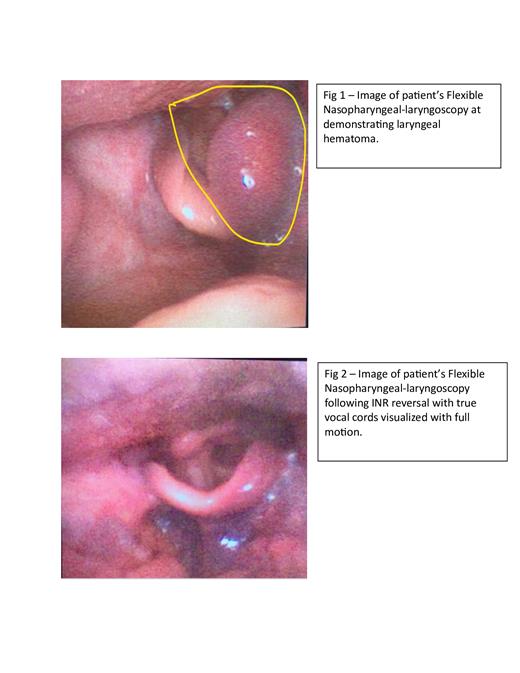Introduction:
Warfarin is one of the most routinely used drugs for anticoagulation. However, it poses a significant bleeding risk. Incidence of major bleeding events ranges from 0.4-7.2% per year, and that of minor bleeding events can be as high as 15.4% per year. Here we present a rare case of laryngeal hematoma due to supratherapeutic INR.
Case description:
A 48-year-old male with past medical history of hypertension, Insulin dependent diabetes mellitus, and multiple episodes of deep venous thromboses on chronic anticoagulation with warfarin presented to the emergency department complaining of left sided neck pain and hoarseness of voice that started and progressively worsened since the past 24 hours. He denies any fever, chills, cough, shortness of breath, or dental pain. He was found to be hemodynamically stable with no oxygen requirement. He spoke with a hoarse voice, but no stridor was noted. Tenderness of the left anterior triangle of the neck below the jawline and mild trismus was noted. Laboratory work-up showed stable hemoglobin of 12.2 and a supratherapeutic INR of 9.9. CT of soft tissue neck showed retropharyngeal fluid collection extending from skull base to C7 with mild to moderate supraglottic airway narrowing. Flexible nasopharyngeal endoscopy showed significant collection of secretions with omega shaped epiglottis and retropharyngeal swelling, raising concerns for a hematoma. INR reversal with 2 units of fresh frozen plasma was initiated and patient was transferred to medical intensive care unit. He underwent daily endoscopies for three days; on day 3 significant improvement of the hematoma size was noted. Daily oral Vitamin K for 3 days ensured INR reversal from 9.9 to 1.7. After transferring to floors, the patient was gradually re-started on his anticoagulation and discharged home safely.
Discussion:
This case exemplified one of the rare but life-threatening complications of supratherapeutic INR. Bleeding into the larynx is a very rare life-threatening complication of chronic anticoagulation with warfarin. Similar case was reported by Cody A. Koch et al in 2010. In 2017 another case was reported which resulted in death from asphyxia before patient was taken to the hospital. A patient with similar presentation and demographics with the index case was reported also in 2019. As per literature, this case will be one of the very few reported cases of Spontaneous laryngeal hematoma due to supratherapeutic INR.
Several factors could potentially affect the INR level of patients on chronic warfarin therapy and can cause acute elevation of INR which can lead to several complications including epiglottal hematoma as seen in this case. The index patient has significant history of chronic diarrhea along with OTC Tylenol ingestion for chronic patient both of which can cause INR increase. Thus, high index of suspicion is important especially for patients with comorbidities due to the fragile interaction of warfarin with several common medications and clinical conditions. Epiglottal hematoma can expand and potentially compromise the airway if immediate reversal of supratherapeutic INR is not commenced.
Regardless of presentation, every patient who exhibits warfarin-associated upper airway hemorrhage should receive treatment that includes stopping anticoagulation, correcting the coagulopathy quickly, closely monitoring the patient's airway in an intensive setting, and having a low threshold for tracheostomy. Given the predicted difficulty with direct and fiberoptic laryngoscopy, the delayed time course for hematoma clearance, and the potential trauma resulting in further bleeding in an anticoagulated patient, securing the airway via intubation is frequently not desirable. Such cases of non-traumatic hemorrhage may be managed medically or surgically. Spontaneous hemorrhage is usually managed conservatively. Regarding the ideal course of treatment, there is, however, no agreement.
Conclusion:
There is need for a high index of suspicion for atypical presentations of supratherapeutic INR (including bleeding into the airway) in patients on prolonged anticoagulation with warfarin. The need for immediate reversal and routine INR monitoring in these patients is also emphasized in this clinical vignette.
Disclosures
No relevant conflicts of interest to declare.


This feature is available to Subscribers Only
Sign In or Create an Account Close Modal